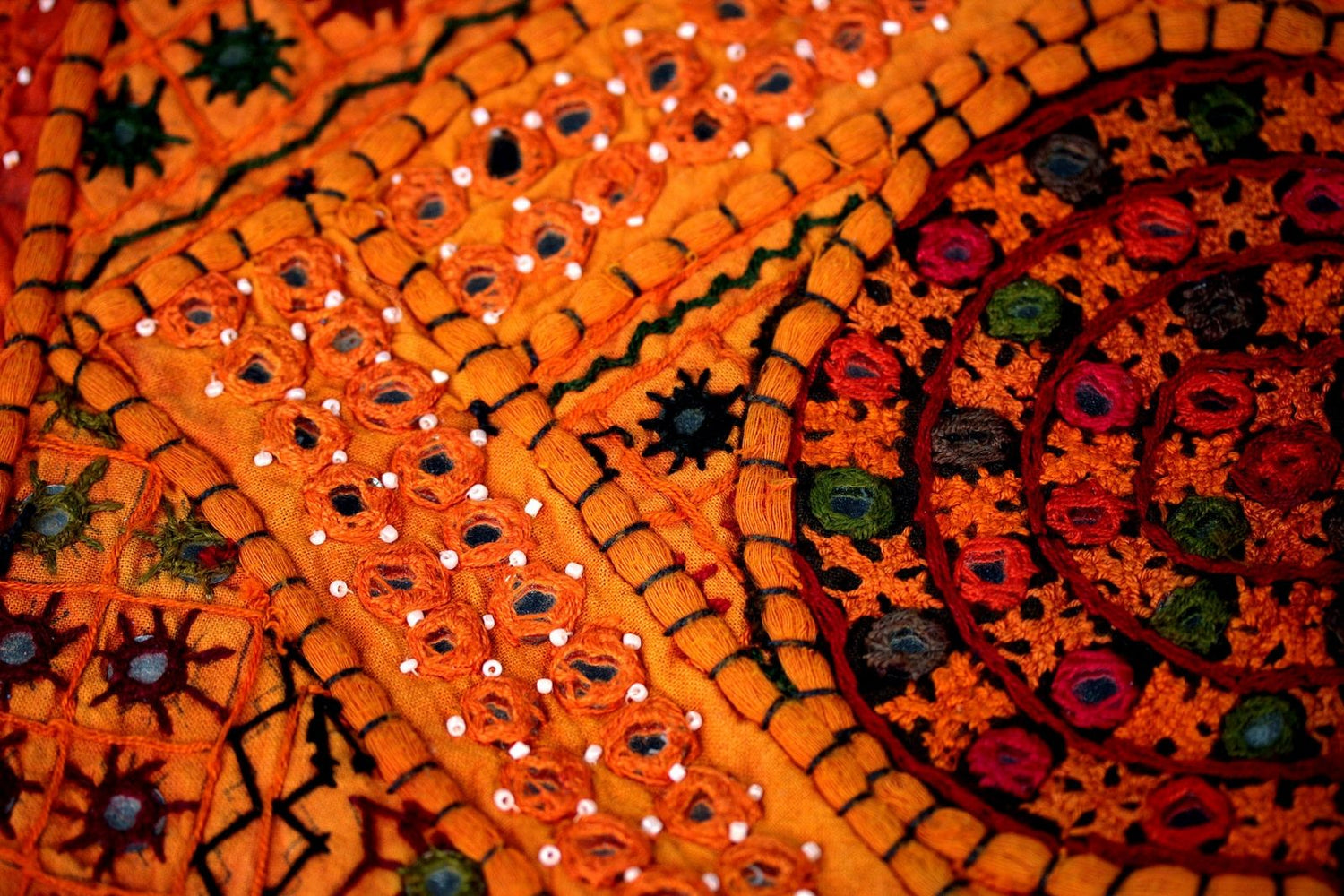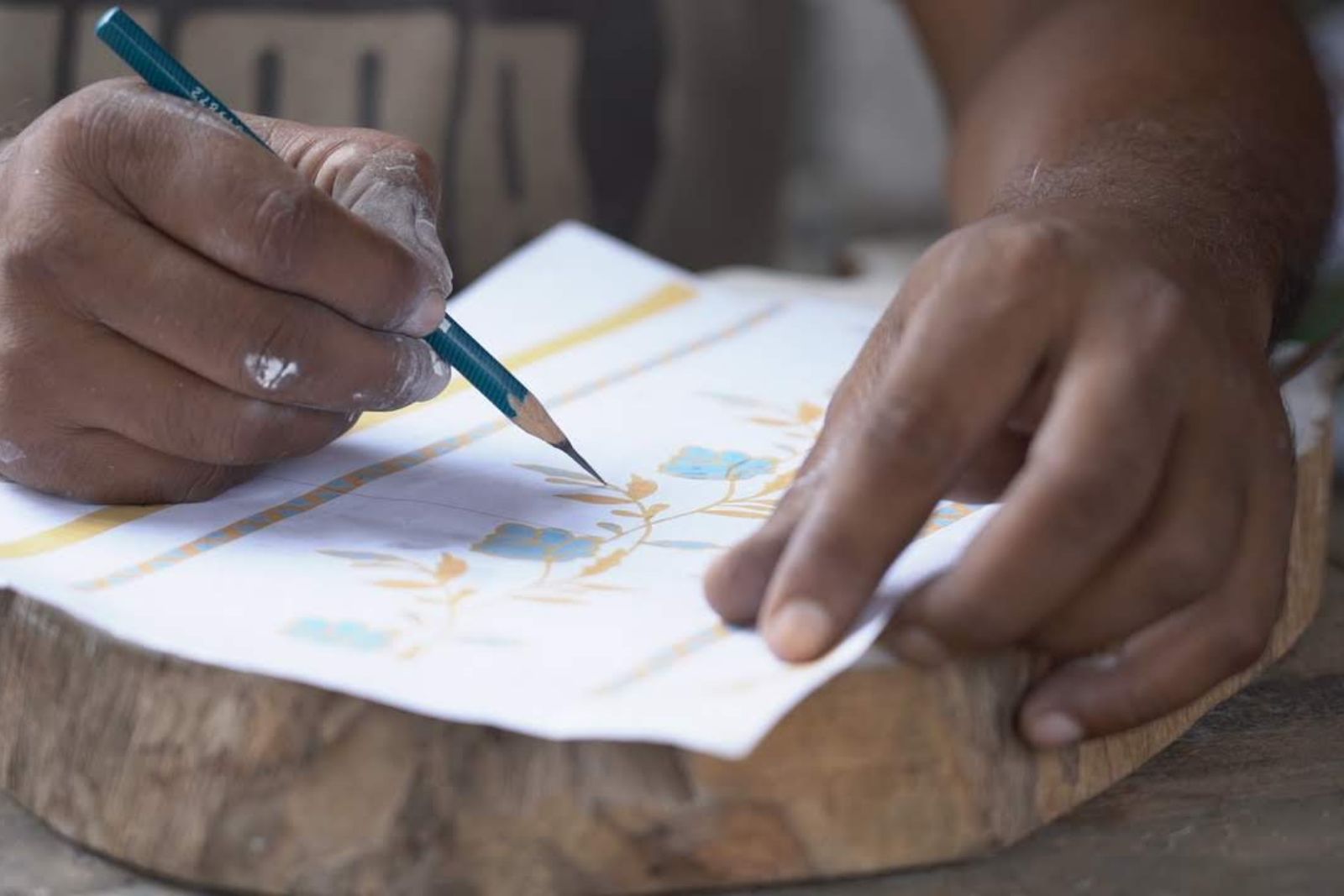In an era where everyone is busy finding a balance in their lives, there are a few people working patiently and laboriously to create handmade treasures for us. Talking about such treasures, embroidery is one such craft technique usually achieved through hands or by employing machines. While machine made embroideries are any day affordable than the handmade threadwork, the latter ones are incomparably dearer to the artisans as they are achieved by investing days of sweat and toil.
India is home to varied embroideries with different states adding their own unique flavor to this thread craft. When a fine needle comes in touch with vibrant threads it says everything about the flora, fauna, beliefs, culture and a lot of other things about that region. Here in this blog, we tried to dig deeper into this glorious technique and explore some of the most popular embroideries of India:
AARI
Aari is a type of needle with a hook at its tip which is used to create appealing designs on any piece of cloth. In the west, it is called a Tambour hook which works quite differently but forms similar patterns. Mughal emperors brought this art in our country and then after states like Gujrat, Uttar Pradesh, Rajasthan and Delhi became the major hubs of its production. You may see aari work in a lot of wedding and occasion wear outfits. Done with silk threads to bind the sequins, pearls and other motifs together, Aari work can add shine and grace to almost any ensemble.
KASHIDAKARI
Kashida work which is prominently found in woolen clothes, shawls, sarees, and cardigans is a specialty of Kashmir. It is made using thick colored threads chosen in contrast to the color of the background fabric. The motifs in Kashida embroidery include birds, flowers, leaves, and vines. Alexander Mcqueen, Prabal Gurung, and Ellie Saab are some of the well-known designers who often draw inspiration from the Kashida work and bring out some unique contemporary designs.
PHULKARI
Phulkari which literally means flower work has its origin in Punjab and is also done in some parts of Haryana and Rajasthan. Earlier this art was confined to one’s home and was not made for commercial selling. Later, with the help of government, this art got its right share and now we can see phulkari work in shawls, salwar-suit, dupattas, jackets, bags, and juttis etc. Well, known designers like Sabyasachi, Gaurang Shah, and Manish Malhotra are often spotted giving a modern-day flavor to this ancient textile craft.
MIRROR WORK
Mirror work which imparts shine to any plain outfit was earlier used to ward off the evil eyes. This art is much popular in Rajasthan and Gujrat where various techniques are used to stitch mirror or mirror-like objects in the fabric. Mirror work is not only used in clothing but is also used for creating decorative curtains, pillow covers, cushion covers, and hangings, etc.
APPLIQUE WORK
Applique is a decorative textile made by cutting out intricate patterns from fabric, gluing it onto a base fabric and stitching these pieces together with hemstitch. Applique artisans belong to a community that migrated from Pakistan during the war of 1971 and settled in the parts of Rajasthan and Gujarat. The artisans use a vibrant color palette to break the monotony of deserts. You can easily find this art in quilting, skirts, jackets, cushion cover, etc. Fashion designers like Hemant Trivedi and Rohit Kumar have helped in getting this local craft get international recognition.
GOTA WORK
We all have witnessed the charm of Gota Patti work, but it takes a huge amount of patience and skill to create one. It includes a variety of steps like printing designs, appliqué work and then hemstitching. Rajasthan is well known for its Gota ribbon work and you are sure to find beautiful lehenga-choli, dupatta, saree, fancy turbans ornate with sparkling Gota work as you stroll through the busy streets of Bapu Bazaar, Jaipur & Bada Bazaar, Udaipur to name a few. Designers like Anita Dongre, Ridhi Arora were seen incorporating Gota work in their designs during Lakme Fashion Week Summer Resort 2018.
KASUTI
Hailing from Karnataka, Kasuti is a traditional folk embroidery known for its unique traditional motifs like chariot, lamps and conch shells. The designs are geometrical in shape and inspired by rangoli patterns. This embroidery is also done with the help of needles and requires 1000-5000 stitches to design a single motif. Unlike other embroideries where one first marks the design and then continues with the embroidery, here one has to count the threads of the warp and the weft to create a design. King of Men’s Fashion Suket Dhir while designing his debut Linen collection in collaboration with Raymond used Kasuti embroidery featuring traditional motifs like parrots and mangoes to accentuate the outfits.
PHOOL PATTI KA KAAM/ FLOWER EMBROIDERY
It is also known as Aligarh work because of its origin. As the name suggests phoolpatti ka kaam is a kind of embroidery where flower and leaf motifs are drawn using colorful threads. This embroidery can be spotted on a variety of Indian ethnic outfits from time to time, especially in the northern and western parts of India. Recently, Nita Ambani was seen wearing beautiful lehenga designed by Sabyasachi, which had a surreal blend of Phoolpatti ka kaam and Kashida embroidery.
KUTCH WORK
Deriving its name from the place itself, Kutch embroidery is a legacy craft of Gujarat. One can spot this embroidery in a jiffy! You are ought to find a burst of green, ivory, indigo, black, deep red, yellow and off-white colors & popping geometric motifs. To make it look richer artisans use beads and mirror to garnish the outfit or fabric. Kutch work looks spectacular on jackets, blouses, saree borders to name a few.
CHIKANKARI
The word Chikankari and Lucknow have become synonyms to each other. It is said that Noor Jahan, wife of emperor Jahangir introduced this craft in the Mughal court. You will mostly find this embroidery in pastel shades and finely textured fabric like cotton, silk, chiffon, and muslin. The soft hues help in highlighting this sober white thread embroidery. However, in recent years the embroidery is being experimented on vibrant fabrics as well. Whether it is Deepika wearing a heavily embellished Chikankari Sari for her wedding reception or Alia in a Lucknowi Embroidered outfit for recent movie promotions, it seems that everyone is drawn by this Nawabi embroidery.
TODA
Toda which means the flower is named after Toda community who belong to Tamil Nadu. It is a quite painstaking embroidery which requires intensive calculation, but the end results are worth it. Young designers like Archana and Vydika are currently researching over this embroidery and are designing wooden bags and purses out of it. Recently Kriti Sanon was also seen wearing a toda embroidered belt for one of her outings while Sonam styled her plain ethnic suit with a toda embroidered dupatta.
KANTHA
Who thought an ancient art of re-using remnants of clothes and old dhotis will become an internationally recognized textile craft. Practiced in parts of Bengal and Odisha, it was ideally the women of old times who introduced Kantha to the world. To achieve a Kantha stitch one uses yarns hauled out from old clothing. You may also spot colorful patches of fabrics sewn together to achieve kaleidoscopic designs in Kantha jackets, quilts, dupattas & more. Designer Sunita Shanker and label 11.11 by CellDSGN have put in great efforts to revive and give a contemporary flavor to this embroidery.
DABKA
Dabka embroidery is an important part of the Indian wedding trousseau. It is the delicate tightly coiled metal spring which is used to create intricate patterns. This 3D embroidery is said to be originated in Rajasthan. Dabka embroidered outfits are quite heavy to carry and usually feature motifs like flowers, vines, birds, animals, cages to name a few. One of the well-known designers in the fashion industry, Gaurav Gupta time and again have done wonders with this embroidery.
GARA
This needlework has many flavors to exhibit. It was the Parsi community of Persia who introduced this craft in the Indian sphere. This needlework is quite detailed and takes up to 809 days to create a 9-yard saree. Today Gara embroidery is blended with various weaves like Banarasi to create ethereal pieces.
PIPLI
Drawing its name from the town itself, Pipli is a craft being practiced for ages in the Pipli town of Odisha. In earlier times Pipli Embroidery was used as a decorative craft during religious ceremonies. Today this art has attracted every tourist eye of Orissa. You can spot Pipli embroidered blouses, jackets and home décor products easily available in the local markets. The Sui Dhaga movie also used Pipli Applique work for creating one of its logos.
ZARDOZI
This embroidery is a specialty of Uttar Pradesh and is also practiced in Delhi, Bhopal, and Hyderabad, etc. This craft can be traced back to the Mughal era, where Zardozi embroidery was done with the help of pearls, stones, gold and silver threads which made it quite lavish & opulent. Today craftsmen use other substitutes to make them affordable. Zardozi embroidery goes perfect on a wedding outfit. You may also check out Sonakshi Sinha’s statement blouse in Kalank movie featuring zardozi work.
No matter how far we come, our roots should never dry up! The fashion industry is indeed working on the same principle and hence are making continuous efforts to revive these rich embroideries and blend them with the modern trends. If you are looking to design something of your own, hop on to Fabriclore.com and get a variety of artisanal fabrics and dupattas, while also featuring a beautiful variety of Lucknowi Chikan, Kantha, Phulkari & more embroideries. To know more about latest trends.
Follow us on:
Facebook: @Fabriclore
Instagram: @fabriclore




